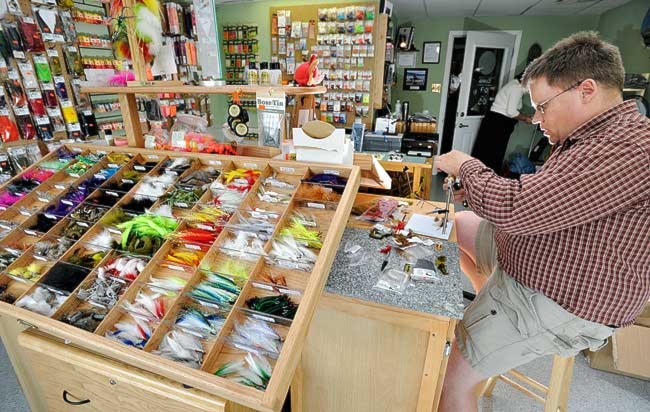If you’re looking for a woolly bugger, Steve Hahn’s your man.
He’s the owner of the On Top Fly Shop. The store, which quietly opened in May, is easy enough to find on Second Avenue, beside Klondike Rib and Salmon Barbecue.
Just look for the door decorated with a stylized drawing of an enormous bug. It depicts a caddis fly - a favourite meal of Yukon’s grayling and trout.
Step inside and you’ll find all manner of fly-angling gear: graphite rods, various lines and reels, and, of course, a large selection of fly lures - some of which Hahn has tied himself.
“It’s a place to tell lies and tie flies,” he said.
Hahn started the business because he was fed-up with ordering supplies online only to find he had been shipped second-rate goods.
Whitehorse’s last fly-fishing shop closed in 2003, by his count. Hahn has seen four such shops shutter over the past 20 years.
In 2006, Hahn started his guiding company, Headwaters 2 Ocean Troutfitter. Two years ago, he began to sell fishing supplies out of his home basement.
Demand grew enough that he jumped at the chance to move into the store’s new space, in the former location of Lilli Pie Lotions.
Hahn sells a fly for every occasion. Many are variations on the mother of all flies, the woolly bugger.
Developed in North America, “it was a down-and-dirty, represent-everything kind of fly,” said Hahn.
“This is a classic woolly bugger,” he said, holding a bushy, black fly, built from a base of copper wire wrapped in synthetic thread and turkey feather. Bits of chicken feather serve as legs.
To a fish, it can resemble everything “from a minnow to a leach to a large dragonfly nymph,” said Hahn.
For more discerning fish, there’s the bead-headed, rubber-legged variety. Or the Bow River woolly bugger, which has sparkly synthetic thread and a heavy weight so it sinks to the bottom.
Hahn sells another fly that’s modelled on the caddis fly seen in his store logo. It has a bright green body and brown wings, made from Chinese hen feathers. It’s called the Peking caddis.
Then there’s the Yukon lite-brite minnow, designed by Hahn himself. He modelled the fly on a similar design by Orvis, but he darkened the body and lengthened the tail.
Its lite brite moniker is due to its bright, sparkly thread. “It’s tremendously reflective,” said Hahn.
“If I could use any fly in the Yukon, it would be this one right here.”
On the store wall are pictures of fish he’s caught with the fly: a four-pound trout and a 19-inch grayling.
To land pike, Hahn recommends the tsunimi - a big, 6.5-inch red fly that’s designed to pop along the water, creating bubbles as it goes. “Pike go absolutely nuts,” he said.
He also has tiny rubber mice and “big honking lemmings,” which pike also eat.
“Pike have actually had baby ducks, mink and marten in their stomachs. They eat pretty much anything if the situation is right,” said Hahn.
Hahn also sells all the materials needed to tie your own flies, including brightly-dyed hair of yak, sheep and rabbit. Hahn likes rabbit hair because “when it gets wet, it gets slinky and it slithers - very attractive to fish.”
Hahn likes tying his own flies for the satisfaction that comes with “actually catching a fish with something you’ve created.” And fly-tiers are able to build custom lures to fit the situation.
Hahn sells a range of graphite rods that cost anywhere between $150 to $500. The pricier models are lighter, stronger and have nicer fits and finishes.
Singlehanded rods continue to sell the best. But, Outside, doublehanded spay rods have grown in popularity in the past few years. So have switch rods, which can be gripped with one or two hands.
Hahn expects they’ll soon catch on in the Yukon, too.
He started fly fishing at 13, while growing up in North Vancouver. He borrowed his father’s rod “and started flogging the water.”
It took him three years to catch his first fish. It was a five-pound rainbow trout “that towed me around the lake” for 45 minutes before he landed it.
“It was awesome. From then on, I was hooked, as it were.”
He taught himself how to fish and tie flies. But just because he suffered his share of frustrations while learning to fly fish doesn’t mean newcomers must.
His store has offered a number of demonstration events, for customers to try out different rods or learn how to tie flies.
The next free fly-tying night is Thursday, July 28 at 6 p.m.
The store is open from Wednesday through Saturday, from 10 a.m. until 7 p.m., and on Sunday from 10 a.m. to 5 p.m.
Contact John Thompson at
johnt@yukon-news.com.
